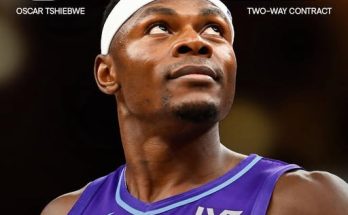The NFL offseason always brings with it a fresh wave of speculation, expectations, and rankings—particularly when it comes to the quarterback position. But few could have predicted the surprising development that surfaced this week: J.J. McCarthy, the Minnesota Vikings’ rookie signal-caller, has been rated higher than Caleb Williams, the No. 1 overall pick in the 2025 NFL Draft and one of the most hyped quarterback prospects in recent memory.
This unexpected twist has stunned fans and analysts alike. McCarthy, who was selected 11th overall by the Vikings, was considered by many to be a promising, but raw, prospect with a strong foundation and championship pedigree. Williams, meanwhile, has long been heralded as a generational talent—often compared to Patrick Mahomes because of his arm angles, improvisational skills, and elite athleticism. So how did McCarthy end up ahead of him in a major quarterback ranking before either has taken a snap in a regular-season game?
The answer lies in a combination of scouting perspectives, organizational situations, and what some evaluators are calling the “intangibles advantage.” While Williams boasts the superior college stats and flashy highlight reel plays, McCarthy’s appeal to NFL insiders has steadily grown thanks to his leadership traits, winning track record at Michigan, and adaptability in a pro-style system.
During his final season at Michigan, McCarthy didn’t post gaudy numbers. In fact, his box score contributions were often overshadowed by the Wolverines’ ground-and-pound offense and elite defense. But what he did do was win—and win big. He went 27-1 as a starter, led Michigan to a national championship, and displayed poise and command in big moments. Scouts praised his football IQ, pocket presence, and willingness to stay within structure rather than chase the hero play.
Those attributes, while less glamorous, matter immensely to NFL evaluators. According to the ranking released by a prominent analytics-driven football outlet, McCarthy edged Williams in several areas they weigh heavily, including decision-making, projected system fit, and coachability. While the ranking doesn’t claim McCarthy is a more physically gifted quarterback, it does suggest he may be more NFL-ready when factoring in the total picture—mental makeup, situation, and team fit.
That’s not to say Caleb Williams has disappointed. By all accounts, the former USC star has impressed early in his Chicago Bears tenure. He’s shown flashes of brilliance in rookie minicamps, displaying the same zip, mobility, and deep ball precision that made him such a coveted prize. Yet, the Bears are a team still in the early stages of a rebuild, and despite adding weapons like Keenan Allen and Rome Odunze, the franchise remains surrounded by questions—especially on the offensive line and in terms of coaching stability.
Meanwhile, McCarthy steps into a more stable environment. Minnesota head coach Kevin O’Connell, a former quarterback himself, is known for developing passers in a system rooted in structure, timing, and rhythm. The Vikings have a more established offensive identity, including playmakers like Justin Jefferson, Jordan Addison, and tight end T.J. Hockenson (if healthy). That structure provides McCarthy with a softer landing spot and could accelerate his transition into the league.
Many around the NFL believe that this difference in circumstances—between chaos and consistency—will be pivotal to the early success of these two young quarterbacks. NFL history is littered with examples of talented prospects whose development was derailed by poor infrastructure, coaching turnover, or lack of protection. The ranking that placed McCarthy above Williams seems to acknowledge this, favoring the environment as much as the individual talent.
But not everyone agrees. Critics of the ranking have been vocal on social media and sports talk shows, calling it premature and reactionary. After all, Williams has yet to face real NFL adversity. Nor has McCarthy. Making sweeping declarations about either player’s trajectory at this stage is fraught with risk. Football is a results-driven business, and rankings in May are rarely remembered by November. However, they do serve as an indicator of perception—and perception often shapes opportunity.
For McCarthy, this could be a blessing or a burden. The Vikings didn’t draft him to sit forever, but the presence of veteran Sam Darnold gives Minnesota flexibility. If McCarthy continues to impress in the offseason program and preseason, O’Connell could make the call to start him early. Conversely, Williams is almost certain to be the Day 1 starter in Chicago, barring injury. The pressure that comes with that—carrying the weight of an entire franchise—is enormous. How each player responds to these pressures will ultimately define whether these early rankings are remembered as prophetic or laughable.
It’s also worth noting that this isn’t the first time McCarthy has been underestimated and then outperformed expectations. Coming out of high school, he was a highly-rated recruit, but questions about his arm strength and ceiling persisted. Even at Michigan, he was often considered more of a game manager than a game changer. Yet, time and time again, he proved his doubters wrong by making clutch plays, protecting the football, and leading with maturity beyond his years. That steady presence is part of what endears him to evaluators. In a league where turnovers kill drives and ruin seasons, McCarthy’s ability to play clean football is an underrated asset.
Williams, on the other hand, is the ultimate swing-for-the-fences quarterback. He can make throws few others dare to attempt. His improvisational ability is his calling card, but it’s also something that could get him into trouble against NFL defenses if not honed properly. One source close to the Bears organization noted that while they are thrilled with his potential, the coaching staff has emphasized the importance of structure and timing during early practices. That learning curve could be steeper than it was in the Pac-12, where Williams often freelanced his way to success.
Another element feeding into this surprising ranking is the growing appreciation among front offices for quarterbacks who can win the mental game. Processing speed, understanding protections, and executing under pressure are all vital components that don’t show up in highlight tapes. In that regard, McCarthy reportedly scored extremely well in pre-draft cognitive tests and whiteboard sessions. Those data points, combined with his humble and team-first demeanor, are often seen as strong indicators of long-term success.
The irony in all of this is that McCarthy, who was labeled the “safe” pick in this draft class, is now being ranked in a way that suggests he might ultimately be the more impactful quarterback early in his career. For Vikings fans, that’s an encouraging sign. After parting ways with Kirk Cousins, Minnesota is hoping that McCarthy can usher in a new era of consistent, high-level quarterback play. The early buzz surrounding him—combined with a strong showing in rookie camp—has only fueled optimism.
For Williams, this should serve as fuel. A competitor at heart, he’s unlikely to take kindly to being ranked behind any of his peers, let alone someone who was picked 10 spots after him. He has all the tools to prove the doubters wrong, and if he can lead Chicago to early success, the conversation will shift quickly. After all, talent doesn’t disappear overnight. But it does need the right environment to flourish.
In the end, it’s important to remember that rankings like these are merely snapshots in time. They reflect perception more than reality. But they also have the power to shape narratives. Whether J.J. McCarthy truly ends up being the better quarterback remains to be seen. What’s undeniable is that he’s already made enough of an impression to turn heads across the league—and that in itself speaks volumes.
As we inch closer to the 2025 NFL season, all eyes will be on McCarthy and Williams. Two rookies. Two different styles. Two different paths. But forever linked by a surprising early twist that few saw coming. The race to prove who truly belongs at the top of the rookie quarterback class has officially begun.



